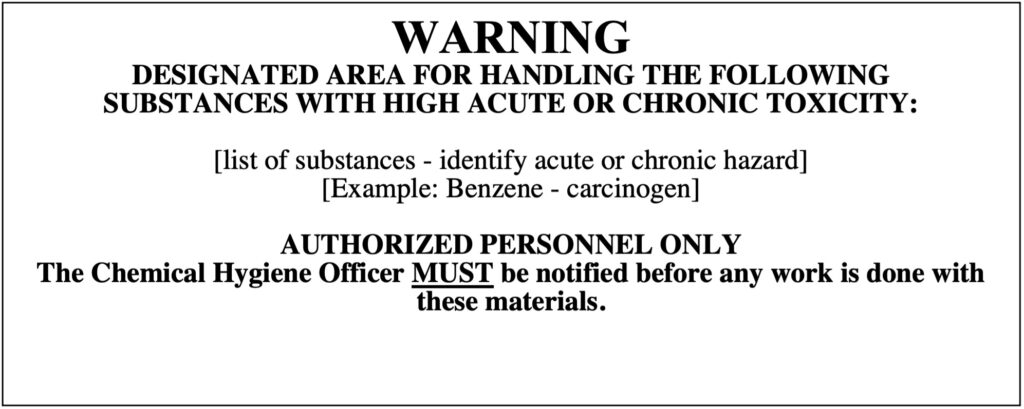3.6.1 General Information
This section establishes supplemental work procedures to control the handling of substances that are known to exhibit unusual acute or long-term chronic health hazards (carcinogens, reproductive toxins and highly acutely toxic substances). This set of procedures applies (https://www.osha.gov/SLTC/carcinogens/standards.html) to chemical carcinogens listed and regulated by the Department of Labor, Occupational Safety and Health Administration (OSHA), and of human carcinogens listed by the International Agency for Research on Cancer (IARC) and the National Toxicology Program (NTP).
OSHA’s Laboratory Health Standard (https://www.osha.gov/SLTC/laboratories/index.html) identifies under what conditions and for what substances the special handling procedures listed below should be used. Please note that a key component in controlling the most hazardous substances is the controlled distribution and use of these substances. In some instances special authorization is required before purchasing and using these substances.
“Chemicals Requiring Prior Approval” lists the substances and/or procedures that require prior approval of the research protocol before beginning work. See Section 1.11 for the chemical safety protocol review process.
3.6.2 Special Handling Procedures
Use these chemicals only in a chemical fume hood or other appropriate containment device (glove box). If a chemical fume hood is used it should be evaluated to confirm that it is performing adequately (a face velocity of at least 100 linear feet per minute (+20%) with the sash at the operating height).
Volatile chemicals should be stored in a vented storage area in an unbreakable, primary or secondary container or placed in a chemically resistant tray (to contain spills). Nonvolatile chemicals should be stored in cabinets or in drawers. Do not store these chemicals on open shelves or counters. Access to all of these chemicals should be restricted.
Volatile chemicals should be transported between laboratories in durable outer containers.
All procedures with these chemicals should be performed in designated areas. Other employees working in the area should be informed of the particular hazards associated with these substances and the appropriate precautions that are necessary for preventing exposures. All designated areas should be posted with a sign which reads:

Vacuum pumps used in procedures should be protected from contamination with scrubbers, traps, or filters.
Analytical instruments or other laboratory equipment generating vapors and/or aerosols during their operation should be locally exhausted or vented in a chemical fume hood.
Skin surfaces which might be exposed to these substances during routine operations or foreseeable accidents should be covered with appropriate protective clothing. Gloves should be worn whenever transferring or handling these substances. Consider using full body protection (disposable coveralls) if the potential for extensive personal contamination exists.
All protective equipment should be removed when leaving the designated area and decontaminated (washed) or, if disposable, placed in a plastic bag and secured. Call the Chemical Hygiene Officer for disposal instructions. Skin surfaces – hands, forearms, face and neck – should be washed immediately.
Work surfaces on which these substances will be handled should be covered with an easily decontaminated surface (such as stainless steel) or protected from contamination with plastic trays or plastic backed paper. Call the Chemical Hygiene Officer for decontamination and disposal procedures; these will be substance specific. Materials that will be disposed of should be placed in plastic bags, labeled and secured.
Chemical wastes from procedures using these substances should be placed in containers and disposed of as hazardous chemical waste. The wastes should be stored in the designated area (defined above) until picked up. If it is possible to safely chemically decontaminate all toxic substances to nontoxic materials during or at the end of the procedure this should be done.
Normal laboratory work should not be conducted in a designated area until it has been decontaminated or determined to be acceptable by the laboratory supervisor or Chemical Hygiene Officer.
If one or more of these substances are used in large quantities on a regular basis (three or more separate handling sessions per week), or for long periods of time (4-6 hours) a qualitative and potentially quantitative exposure assessment should be performed. Contact the Chemical Hygiene Officer to have this assessment performed. The Chemical Hygiene Officer in conjunction with the University Physician will determine if it is appropriate to establish an ongoing medical surveillance program.
Lab personnel of childbearing age should be informed of any known male and female reproductive toxins used in the laboratory. An employee who is pregnant, or planning to become pregnant and who is working with potential reproductive toxins that might affect the fetus, should contact the Chemical Hygiene Officer to evaluate their exposure and inform her personal physician. The Chemical Hygiene Officer can assess potential exposures and work with the employee and laboratory supervisor, if necessary, to adjust work practices to minimize the potential risk.

